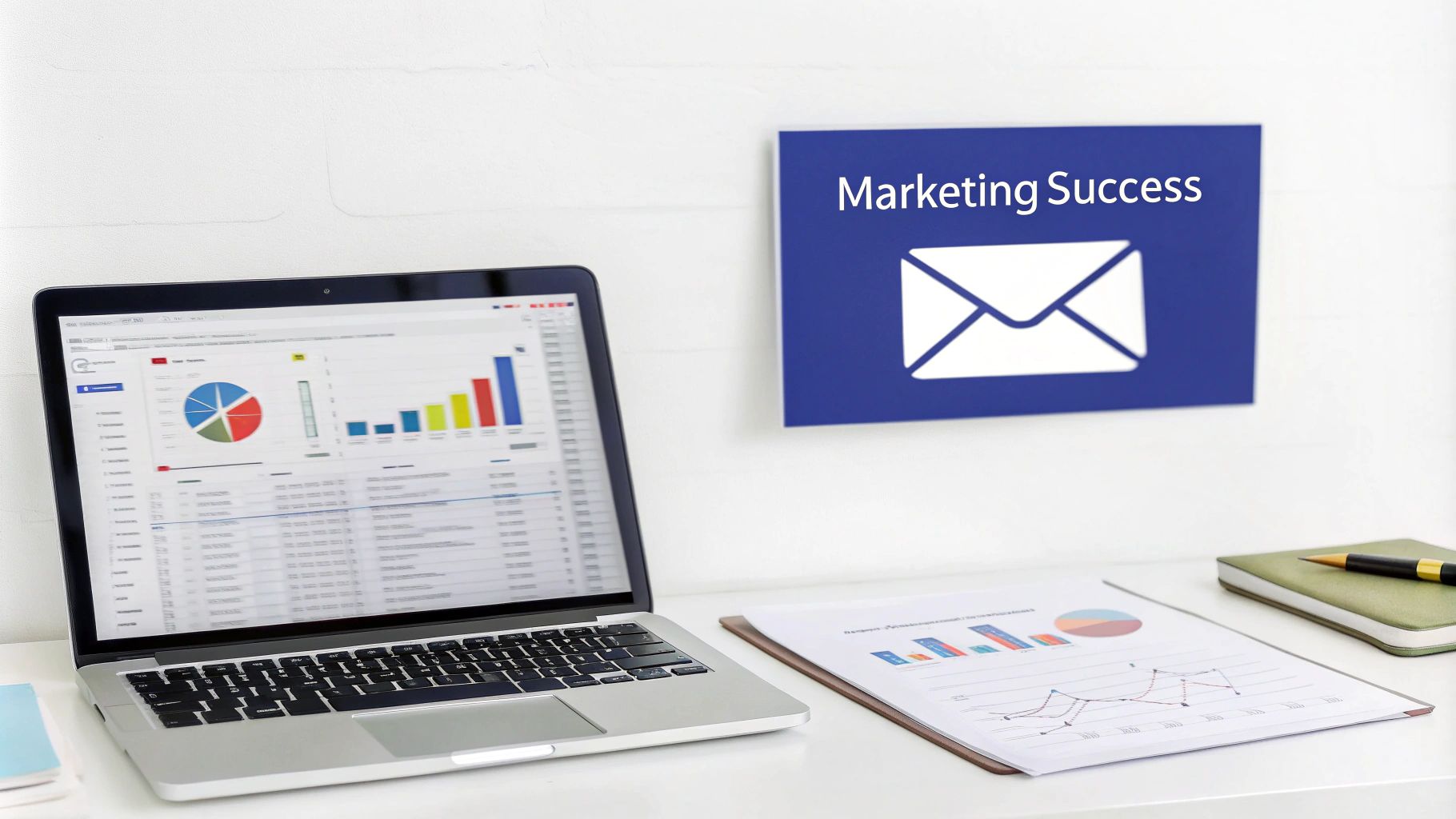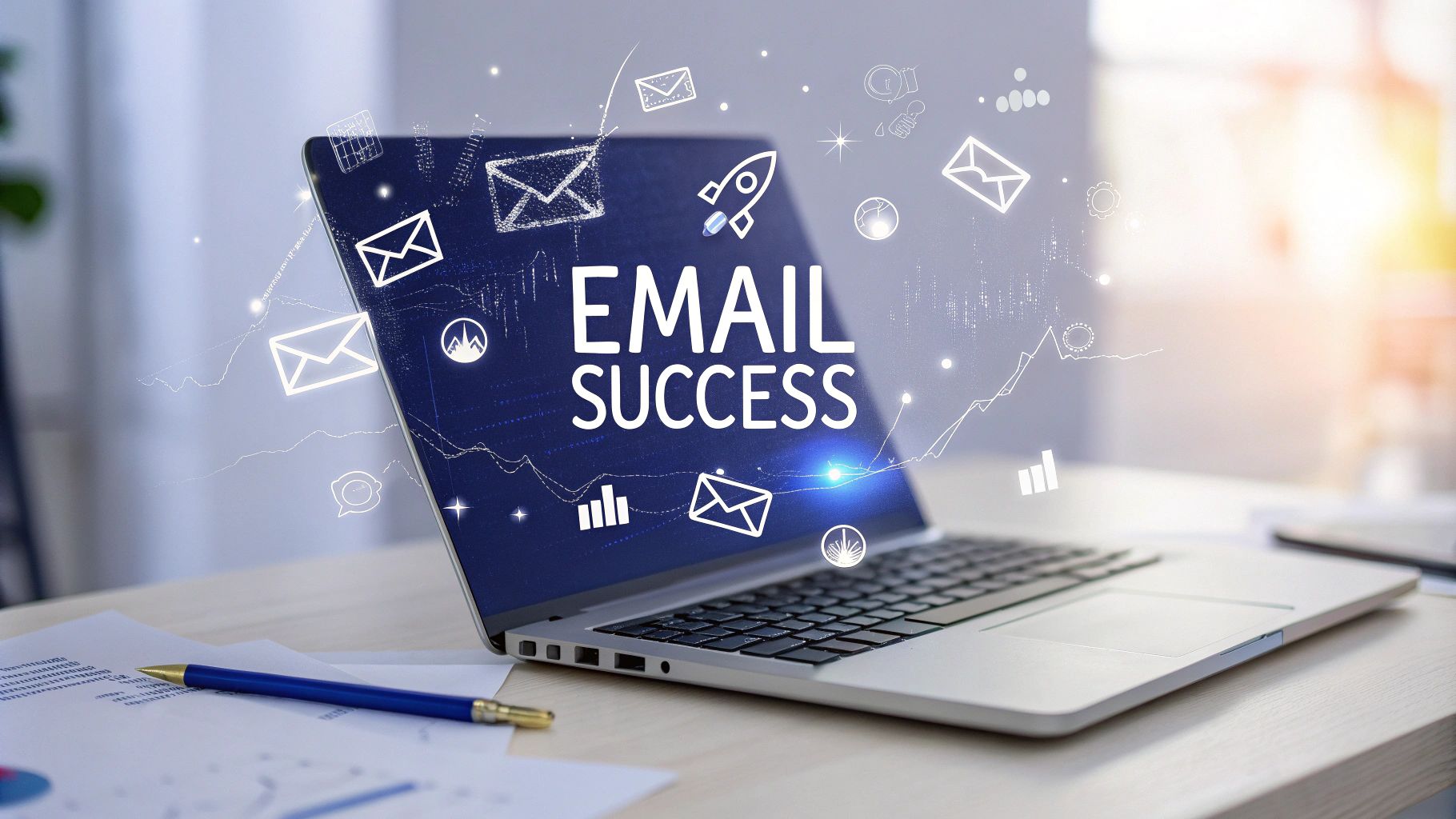Email Marketing Essentials

Effective email marketing transcends mere mass mailings; it's about forging strategic connections with your audience. This necessitates understanding best practices that cultivate engagement and drive conversions. In essence, implementing core principles ensures your emails resonate with recipients and achieve your marketing goals.
The Power of Personalization
One cornerstone of effective email marketing is personalization. Much like a tailored suit fits perfectly, unlike a generic size, personalized messages cater to individual needs and preferences, while generic email blasts often miss the mark. This targeted approach enhances the chances of grabbing attention and establishing a connection. For instance, using the recipient's name in the subject line or referencing past purchases demonstrates individual attention. This personal touch not only increases open and click-through rates but also strengthens customer relationships, setting the stage for long-term engagement.
Segmenting Your Audience
Building on personalization is the crucial element of segmentation. Just as a chef carefully chooses ingredients, a marketer segments their email list to deliver the appropriate content to the right individuals. Dividing subscribers into groups based on demographics, behavior, or purchase history allows for tailored messaging that aligns with their specific interests. This heightened relevance minimizes the risk of unsubscribes while maximizing engagement. As a result, segmentation allows for more targeted messaging and strengthens overall campaign performance.
Optimizing for Mobile Devices
Given the dominance of mobile devices, optimizing emails for these platforms is paramount. With a substantial volume of emails opened on smartphones and tablets, proper rendering is essential for a positive user experience. A poorly formatted email can quickly lead to frustration and deletion. This involves using responsive design to accommodate various screen sizes. Clear, concise content, legible fonts, and prominent call-to-action buttons are also critical. However, mobile optimization extends beyond formatting; it involves recognizing how people use their phones. Short subject lines and easily digestible content are essential for mobile engagement.
Automating for Efficiency and Relevance
Automation enables the timely delivery of relevant emails without manual effort. Like a sprinkler system consistently waters a garden, automated email sequences can nurture leads, welcome new subscribers, or address abandoned carts. This consistent communication maximizes engagement opportunities. For example, a welcome series can introduce your brand and its offerings, fostering positive initial interaction. Abandoned cart emails can encourage purchase completion, recovering potentially lost sales. These automated sequences operate seamlessly, driving conversions while freeing up your time. These practices collectively contribute to campaign success.
Building Quality Email Lists

Effective email marketing relies heavily on cultivating a strong and engaged email list. Just as a farmer prepares fertile ground before sowing seeds, a healthy subscriber base is essential for campaign effectiveness. This section explores strategies for building and maintaining this cornerstone of successful email marketing.
Organic List Building: Quality over Quantity
Prioritizing organic list growth, comprised of genuinely interested subscribers, is paramount. The focus shouldn't be on sheer numbers, but attracting the right audience. This involves offering valuable incentives for signup, such as exclusive content, discounts, or early access to products. For example, a free e-book or a discount code can be highly effective. This not only encourages signups but also ensures subscriber interest. Clearly communicating the value of joining your list—whether it's informative newsletters or special offers—is also crucial.
Opt-In Strategies: Respecting Subscriber Choices
Implementing clear opt-in methods is vital. Requiring explicit consent, rather than automatically adding subscribers, builds trust and establishes a positive relationship. Double opt-in, where subscribers confirm via email, is a recommended practice to verify addresses and reinforce consent. Furthermore, offering easy unsubscribe options reinforces your respect for subscriber choices and contributes to a healthier, more receptive list.
Maintaining List Hygiene: Keeping Your List Fresh
Regularly maintaining your email list is essential for maximizing deliverability and engagement. Just as a gardener weeds a garden for healthy growth, removing inactive or invalid addresses prevents your emails from being marked as spam. This ensures messages reach their intended recipients. This focus on quality, respect for subscriber choices, and list hygiene cultivates a highly engaged audience more receptive to your marketing efforts, thereby maximizing campaign ROI.
Creating Engaging Content
Coupled with a healthy email list and best practices is the necessity of compelling content. This means carefully considering both what you communicate and how you communicate it. This section explores guidelines for creating engaging content that captures attention and encourages interaction, leading to higher open rates, increased clicks, and ultimately, better conversions.
Crafting Compelling Subject Lines
The subject line is your first impression. Like a book cover, it must be enticing. An effective subject line is concise, intriguing, and clearly conveys the email’s value. For example, instead of "New Products," try "Exclusive Sneak Peek: New Summer Collection." This sparks curiosity and sets expectations. Personalizing the subject line with the recipient's name can further enhance open rates.
Writing Engaging Email Body Content
Once the subject line has captured attention, the email body must deliver. This means providing valuable information in a clear, concise, and engaging format. Start with a strong opening that states the email's purpose. Use short paragraphs, bullet points, and visuals to enhance readability, especially for mobile users. For instance, if announcing a sale, clearly highlight the discount and duration for easy access and immediate action.
The Power of Visuals
Visuals, such as images, GIFs, and videos, can greatly enhance engagement. They can break up text, inject personality, and convey information effectively. For example, product images or a short demonstration video can significantly increase click-through rates. However, strategic use is key; too many visuals can clutter the email, especially on mobile. Optimizing visuals for different devices and email clients is essential to avoid display issues.
Call to Action: Guiding the Next Steps
Every email needs a clear call to action. This directs the recipient towards the desired action, whether it's visiting your website, making a purchase, or downloading a resource. A strong call to action is concise, action-oriented, and visually prominent. Use specific language like "Shop Now" rather than a generic "Learn More." Ensure accessibility on both desktop and mobile for seamless engagement. By following these practices, you can create resonating content that drives conversions and reinforces your brand.
Optimizing Send Times

Engaging content and a quality email list are fundamental, but timing is equally crucial. Even the most compelling email can be ineffective if sent at the wrong time. Strategic timing maximizes impact and ensures visibility. This section explores email scheduling and timing strategies to improve campaign performance.
The Importance of Timing
The timing of your email sends significantly influences open and click-through rates. Understanding your audience's behavior is key. Sending emails during peak work hours risks them being buried, while sending them too late might lead to them being missed entirely. Analyzing your audience data is therefore vital for identifying optimal send times.
Identifying Optimal Send Times
There isn’t a universally ideal send time. A/B testing is an invaluable tool. By sending identical emails to smaller segments at different times, you can analyze open and click-through rates to determine the most effective windows. This data-driven approach allows for personalized scheduling. Consider platforms offering send-time optimization features, which use algorithms to determine the best times based on past engagement.
Frequency: Finding the Right Balance
Email frequency is equally important. Too many emails can lead to fatigue and unsubscribes, while too few can cause your brand to be forgotten. The ideal frequency depends on your industry, audience, and content. Start by testing different frequencies and monitoring engagement to find the balance that keeps your audience engaged without overwhelming them. Weekly newsletters might suit one audience, while others might prefer more frequent updates on offers or product releases.
Day of the Week Considerations
The day of the week significantly impacts email performance. While Fridays often have high open rates, they might not have the highest conversions. Mondays can be overwhelming for recipients, and Thursdays and Fridays often see decreased engagement as people prepare for the weekend. Testing and data analysis are essential for determining the best send days for your particular audience. This ongoing optimization refines your strategy and yields the best results.
Mobile Optimization
Mobile optimization is an essential element of best practice in email marketing. Your emails, much like a storefront, should be accessible and engaging regardless of how they are viewed. With the majority of emails opened on mobile devices, ignoring mobile optimization means potentially losing a significant portion of your audience. This section discusses key strategies for ensuring optimal rendering and functionality on all mobile devices.
Responsive Design: Adapting to Different Screens
Responsive design is the foundation of mobile optimization. It allows your email to adjust its layout and formatting dynamically based on screen size. This ensures clarity, readability, and visual appeal across devices, from smartphones to desktops. This involves using fluid layouts, flexible images, and media queries to tailor the email's appearance.
Concise Content and Clear Formatting
Mobile screens require concise, easily digestible content. Avoid long sentences and dense paragraphs. Opt instead for short, impactful sentences, bullet points, and clear headings to enhance scannability. Use legible fonts and comfortable font sizes for improved readability on smaller screens.
Prominent Call-to-Actions
Your call to action (CTA) must be highly visible on mobile. Make CTA buttons large and easily tappable. Use contrasting colors to attract attention and ensure prominence within the email layout. Clear and concise CTA text like "Shop Now" encourages immediate action. You might be interested in: How to master mobile user feedback.
Subject Line Brevity
Subject lines make the first impression. On mobile, where subject lines are often shortened, brevity is paramount. Craft concise, impactful subject lines that grab attention and encourage opens, even on smaller screens. Focus on the core value proposition of your email to ensure that the entire message is visible and maximizes the chances of capturing the recipient’s attention. This, combined with other best practices, ensures effective message delivery in our mobile-centric world.
Measuring Success
Effective email marketing requires careful analysis of campaign performance. Like a ship's captain charting a course, marketers must track metrics and analytics to understand what's working and how to optimize strategies. This data-driven approach maximizes the return on investment.
Key Performance Indicators (KPIs)
Several key performance indicators (KPIs) offer insights into your email marketing effectiveness. These metrics act as a guide to better campaign performance.
-
Open Rate: This measures the percentage of recipients who opened your email. A high open rate suggests an effective subject line and targeting. However, factors like preview text and sender reputation also play a role.
-
Click-Through Rate (CTR): CTR measures clicks on links within your email. A high CTR signifies engaging content and effective calls to action.
-
Conversion Rate: This tracks the percentage of recipients who completed a desired action, like purchasing or signing up. A high conversion rate indicates a successful campaign that moved recipients through the sales funnel.
-
Bounce Rate: This indicates the percentage of undelivered emails. A high bounce rate can signal issues with your email list, impacting sender reputation and deliverability.
-
Unsubscribe Rate: This tracks opt-outs. A high unsubscribe rate can point to problems with frequency, relevance, or targeting, highlighting the importance of respecting subscriber preferences.
Analyzing and Interpreting Data
Collecting metrics isn’t enough; they must be analyzed to extract actionable insights. Look for trends and patterns to identify areas for improvement. For instance, a consistently low CTR might suggest a need for more compelling calls to action. Comparing metrics across campaigns can reveal what resonates most with your audience. Read also: 13 user engagement metrics to track in 2024.
Tools and Resources
Various tools can assist in tracking, analyzing, and interpreting data. Email marketing platforms often include analytics dashboards. Third-party tools can offer more granular data and advanced reporting. These resources empower marketers with deeper insights for data-driven decisions, ensuring continuous optimization for maximum impact.
Streamline your feedback process and boost team collaboration with BugSmash. Start your free trial today!




